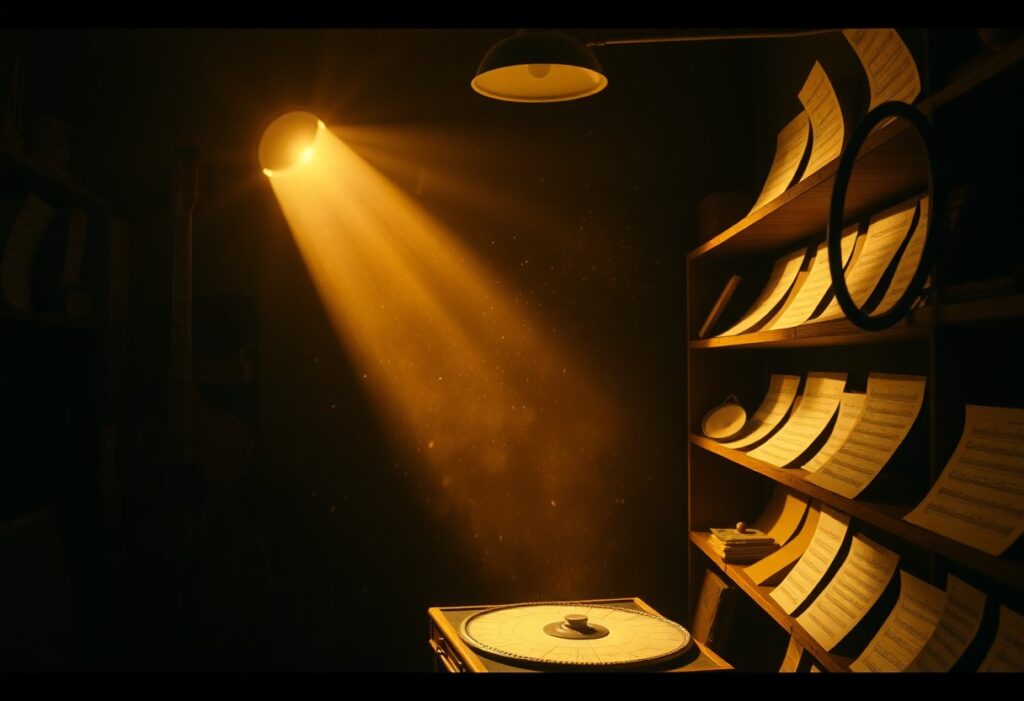With them sinister vibes flowin’ through them beats, you come across a whole squad of obscure instruments ready to hit you with the haunting sounds that stick to your soul. You ain’t gotta stick to the mainstream when these hidden gems can elevate your tracks to a whole new level, unleashing ethereal tones that’ll send chills down your spine. Time to explore what’s out there, and trust, you don’t wanna sleep on these crazy finds that bring that extra flavor to your musical game.
Key Takeaways:
- Obscure instruments like the glass armonica and theremin create unique, ethereal sounds that evoke haunting emotions.
- Traditional and modern interpretations of lesser-known instruments can enhance the atmosphere in various genres of music.
- Exploring unconventional instruments expands the sonic palette for composers and musicians, fostering creativity and innovation.
Unveiling the Uncommon: A Selection of Obscure Instruments
It’s time to explore the world of instruments that don’t usually get the spotlight but are straight-up magic for your ears. From the eerie vibes of electronic soundscapes to glass melodies that dance in the air, these unique tools are where the art meets a haunting sound. You’ll want to tune in and explore what makes these gems resonate.
The Theremin: The Electronic Enigma
The theremin’s not just a pretty face; it’s that unearthly vibe you didn’t know you needed. Played without touching it, this wild electronic instrument responds to your bodily movements, channeling notes that feel like they’re drifting in and out of reality. Its sound has graced everything from classic sci-fi flicks to avant-garde performances, sending chills down your spine and making you feel some kind of way.
The Glass Armonica: A Melodic Mirage
The glass armonica’s vibes are all about that ethereal flow. With spinning glass bowls, it creates hauntingly beautiful tones that resonate deep in your soul. When you glide your fingers over the rims, the sound is practically otherworldly, transporting you to another dimension of music you didn’t know existed.
Invented by Benjamin Franklin in the 18th century, the glass armonica combines science and art in a fresh way. Each bowl tunes to a different pitch, producing a captivating harmony when played right. Notable composers like Mozart and Beethoven penned pieces specifically for it, proving its influence in history. In a room filled with its ghostly melodies, it feels like you’re caught in an enchanting dream, making you reconsider how sound can weave through your emotions.
Resonance and Emotion: How Unique Sounds Affect Us
Every time you vibe with those oddball sounds, you’re catching some deep feelings that hit right in the soul. These unique tones can tug at your heartstrings, stirring up nostalgia, sadness, or even joy. Obscure instruments resonate at frequencies that tap directly into your emotions, creating a rich tapestry of sound that unfolds stories you didn’t even know you had inside you.
Psychological Impact of Unconventional Tones
Unconventional tones got mad psychological power, shaping your feelings in moments you least expect. Whether it’s the eerie notes of the glass armonica or the otherworldly wails of the theremin, these sounds mess with your mind, triggering a cascade of memories and emotional responses that traditional tunes can’t touch.
Cultural Significance of Haunting Sounds
The cultural weight behind haunting sounds runs deep, connecting generations through shared experiences. As timeless as the stories they accompany, these eerie frequencies are often found in folklore and spiritual rituals, solidifying their place in tradition while holding unique meanings across different societies.
Think about the power of sound in culture; globally, haunting vibes play a key role in rituals, storytelling, and healing practices. For instance, the carnatic music tradition in South India often employs instruments like the veena to evoke emotions tied to love or loss, while Indigenous cultures use the droning of the didgeridoo to connect with ancestral spirits. These sounds aren’t just music—they’re pathways to emotional resonance that tie communities together, spreading vibes across time and space.
Craftsmanship Behind the Sound: Building the Instruments
Building these haunting instruments ain’t just a trade; it’s a vibe. Luthiers and artisans tap into generations of skill, melding tradition with innovation. Each piece is unique, shaped by the hands that know how to coax out its soul. The way they carve wood, shape metals, and blend textures creates a soundscape that’ll creep into your consciousness. Get ready to discover the magic behind that eerie resonance.
Materials and Techniques: From Ancient to Modern
Every haunting note comes from a blend of ancient wisdom and modern flair. You’ve got wood like mahogany and spruce, prized for their tonal qualities, while metal components often take inspiration from traditional craftsmanship. Artisans now mix these classics with synthetic materials, pushing the boundaries of sound. Whether it’s a vintage sitar or a modern sampling machine, the heart of these instruments beats with the echoes of the past, reimagined for today.
The Art of Tuning: Frequency and Harmony
Tuning’s where the real magic happens, transforming raw sound into ethereal vibrations. You vibe with the frequencies, aligning them to evoke emotion and mood. It’s a delicate balance; one tweak can switch it from haunting to heavenly. Experienced musicians know how to adjust tension and resonance, finding just the right pitch to pull on your heartstrings.
When you’re tuning, it’s all about those micro-adjustments. Just a notch too tight or loose can change the whole game. Think of it like a chef seasoning a dish; too much or too little ruins the flavor. Mastering frequency means understanding harmonic overtones and how they interact, creating that captivating blend you can’t resist. That’s the essence of tuning—bringing instruments to life, crafting sounds that stay with you long after the last note fades out.
The Haunting Melodies: Iconic Uses in Popular Culture
From eerie soundtracks to spine-tingling performances, obscure instruments have shaped some of the most unforgettable moments in pop culture. The raw, haunting tones of these unique sounds resonate with audiences, capturing their imagination and stirring deep emotions. Whether it’s the melodic whirr of the theremin in sci-fi classics or the ghostly notes from the hang drum, these instruments amplify the unease and beauty of chilling narratives, making them iconic choices for creators looking to add a layer of depth to their stories.
Film Scores that Chill the Spine
Think of a film that left you breathless, and chances are, a unique sound crept into that experience. The theremin’s otherworldly wail in *The Day the Earth Stood Still* takes you on a haunting ride, while the strings of the saw add an unsettling vibe in *A Ghost Story*. These scores are not just backdrops; they’re characters in their own right that pull you deeper into the story and stay in your head long after the credits roll.
Influential Artists Embracing the Obscure
Major players in music have tapped into this eclectic vibe, flexing their creativity with obscure instruments. Artists like Björk flaunt the hang drum to create dream-like soundscapes, while alt-rockers Radiohead toss in the ondes Martenot for that extra creep factor. When you dive deep into their catalog, you hear how these instruments drive the emotion and storytelling, pushing sonic boundaries and giving fans vibes that stick.
Björk’s experimentation with the hang drum in tracks like “Cocoon” showcases how these unconventional sounds shape emotional narratives, adding layers of complexity. Radiohead’s use of the ondes Martenot in “How to Disappear Completely” creates a haunting atmosphere that resonates with listeners, pulling them into a melancholic journey. These artists prove that embracing the obscure not only enriches their music but also invites you to experience a broader spectrum of sound, engaging your mind and soul in a visceral way.

The Future of Obscure Instruments: Revival or Obsolescence?
The future of obscure instruments stands at a crossroads, where you can either catch a vibe of revival or watch them fade into the shadows. As music evolves, the demand for unique sounds is strong, and that’s the perfect window for these rare tools to shine. Genre-blending artists are pulling these hidden gems from the attic, breathing new life into their grooves and bringing fresh flavors to the game. Will you vibe with the revival or let these haunting sounds slip away?
Emerging Artists Reshaping the Soundscape
New players in the scene, hungry for that authentic feel, are snatching up obscure instruments and flipping the script. These emerging artists are blending styles and genres, pushing boundaries with sounds you’ve never heard before. Think about producers mixing a theremin with trap beats or a music box sampling in a hip-hop track. It’s a fresh take, and it keeps you tuned in and guessing what’s next.
Technology’s Role in Preserving Obscure Instruments
Tech tools are the new lifeline for obscure instruments, making it easy to keep the legacy alive. Digital libraries and online communities are keepin’ it real, providing access to rare sounds and resources for makers and musicians alike. This ain’t just about saving instruments; it’s about creating platforms that connect you to the past while you jam in the present.
With advancements like 3D printing and software modeling, reconstructing damaged or rare instruments has become a reality. Digital sampling allows you to explore and manipulate recordings of these elusive sounds, making them more accessible than ever. Social media empowers artists to showcase their work, sparking interest in these instruments among new generations. Platforms like SoundCloud and Bandcamp create a direct line to niche audiences, ensuring that you get your hands on the sounds that echo through the ages. Technology isn’t just preserving; it’s pushing these instruments into the spotlight, allowing you to fully experience their haunting resonance in your own projects.
Final Words
With this in mind, you gotta dig deep into those obscure beats that make your soul vibe. Instruments like the waterphone and the hang drum bring haunting sounds that hit different, resonating with your inner feels. So, when you out there looking for that unique sound to elevate your tracks, keep these gems in your lineup, ’cause they’ll add that magic touch you didn’t know you needed. Let those haunting echoes be the backdrop to your story, and let your art take flight like never before.
FAQ
Q: What are some examples of obscure instruments that create haunting sounds?
A: Instruments such as the Serbian gusle, the Indian shruti box, and the Japanese shō are known for their unique tonal qualities. The gusle produces a deep, resonant sound that complements folk storytelling, while the shruti box generates drone-like sounds used in Indian classical music. The shō, with its multiple bamboo pipes, offers ethereal and complex harmonics.
Q: How do these instruments contribute to creating a haunting atmosphere in music?
A: The distinctive tonal qualities and unconventional scales of these instruments evoke mysterious and otherworldly feelings. Their often resonant and airy sounds can create an emotional ambiance, enhancing the thematic elements of compositions that seek to convey haunted or surreal experiences.
Q: Are there any contemporary musicians known for incorporating these instruments into their work?
A: Yes, artists like Björk frequently use unconventional instruments to explore haunting soundscapes, as well as composers like Max Richter, who blends classical and modern elements with obscure instruments to evoke deep emotional responses in listeners.


